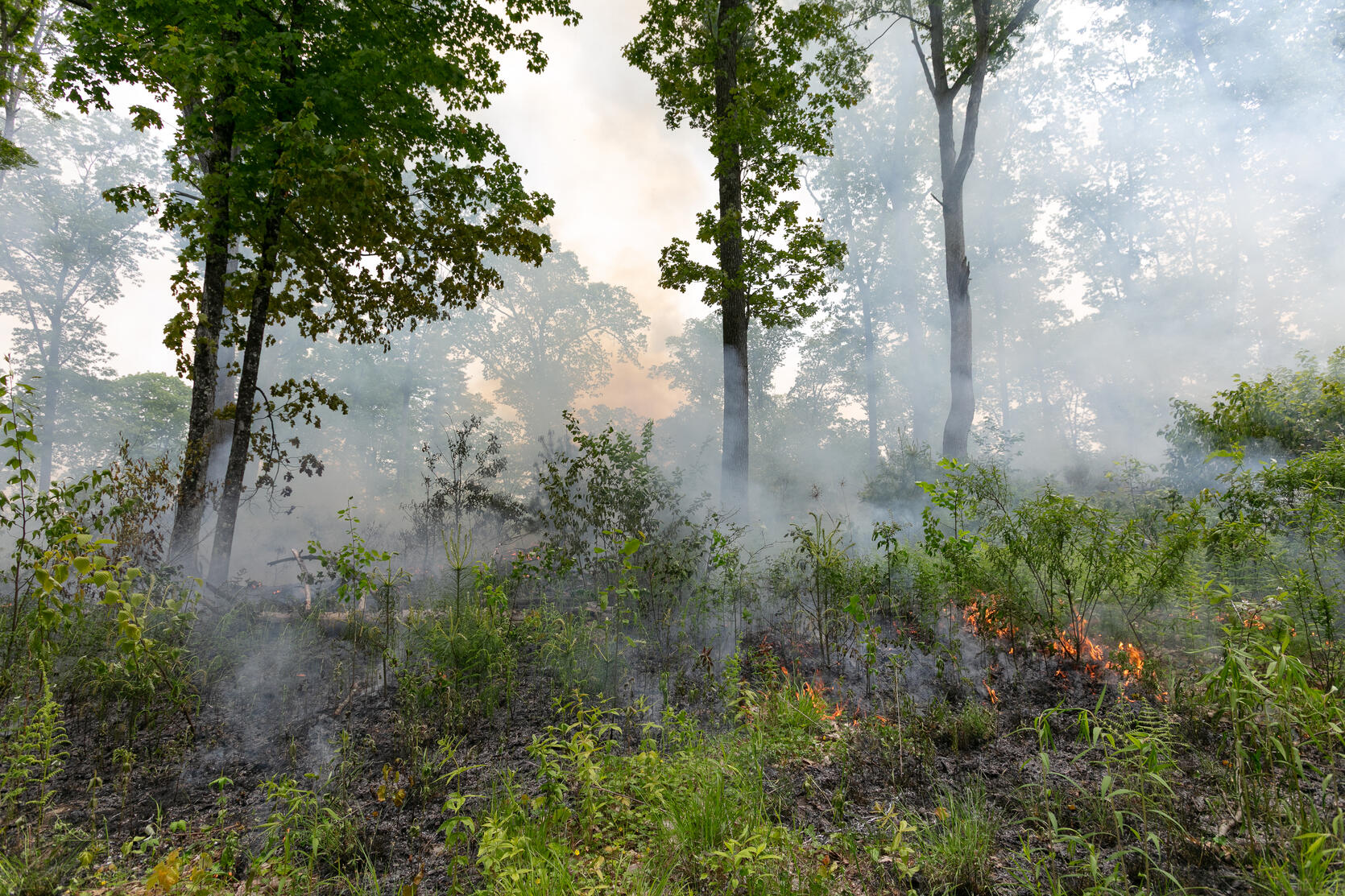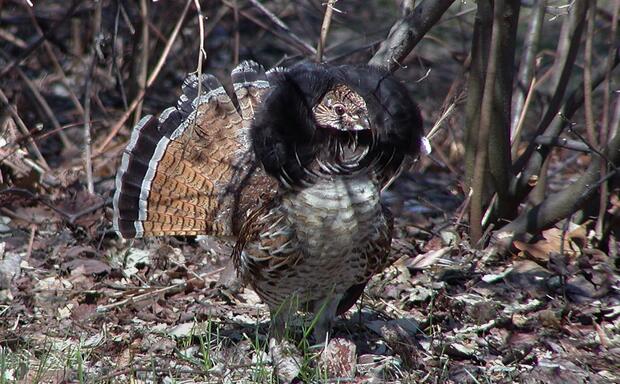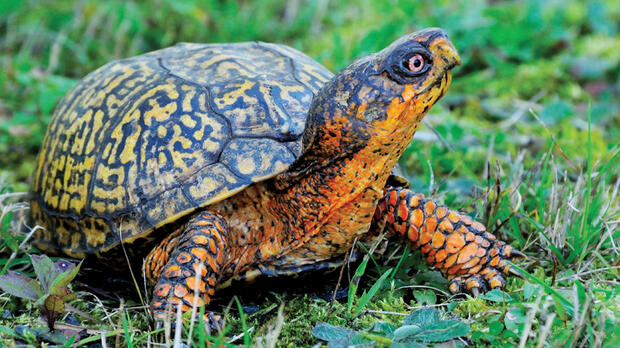- Division of Fisheries and Wildlife
Media Contact
Media Contact, MassWildlife

For thousands of years, fire has shaped Massachusetts’ landscape and has benefited wildlife by altering different elements of their habitat. Other management techniques such as mowing, plowing, planting, or herbicide treatments may be used to achieve some habitat goals, but there is no substitute for the unique effects fire produces. Fire can benefit wildlife by affecting habitat in four major ways: shifting structure (referring to height, density and arrangement of vegetation), influencing plant composition (favoring species adapted to frequent fire), increasing food availability and nutrition for wildlife, and creating a shifting mosaic of habitats across the landscape through the variable nature of fire.
You might already be familiar with the positive impact periodic fire has on game animals like deer and turkey as well as on rare species like the frosted elfin and eastern whip-poor-will, but there is a long list of common and declining species that benefit from habitats managed with prescribed fire. Learn about a few species that may surprise you below.
Grasshopper sparrow
This bird is a state threatened and regionally rare songbird that requires large areas of sandplain grassland habitat (usually more than 30 acres). Large areas of sandplain grasslands are now rare in Massachusetts, and therefore the wildlife that need these grasslands to survive and thrive are often rare as well. Grasshopper sparrows eat, sleep, and nest on the ground. When threatened by a predator, they scurry along the bare ground between clumps of grass rather than fly. The clumps of native warm season grasses are umbrella shaped, providing overhead protection for nests and cover from predators while also offering space on the ground to move and forage. Grasshopper sparrows survive largely on insects, which are abundant in fire-managed grasslands.
Ruffed grouse
Over the past few decades, the iconic spring “drumming” echoes of ruffed grouse have dwindled across Massachusetts, partly because specific habitats this game bird requires have come to be less common. Though they use a variety of forested habitats, ruffed grouse particularly need dense, brushy shrublands and young forests between 5 and 30 years of age offering ample food and cover from predators. Currently, less than 10% of Massachusetts forest habitats contain these ephemeral habitats. Without regular disturbances such as blowdowns, cutting, or burning, these habitats quickly mature, no longer suiting our native partridge’s specific needs. Prescribed fire improves the habitat structure needed in all life phases of ruffed grouse. As chicks, ruffed grouse require a protein-rich diet of insects that are abundant in fire-managed landscapes. On recently burned areas, broods of young grouse can readily roam the forest floor, making it easier for them to find food and escape predators. As adults, ruffed grouse rely on the seeds of herbaceous plants, especially legumes, and short-lived trees and fruiting shrubs such as sun-loving cherry, aspen, and hazelnut. In pine barrens, ruffed grouse feed on the abundant nuts produced by scrub oak and hazelnut in the fall. The highly nutritious flower buds of both shrubs are available in the late winter and early spring when few other foods exist.
Bats
They may not normally be considered the poster child for prescribed fire, but fire can play an important role in ensuring good habitat for bats. Fire can be helpful to bats, including the state declining (species of special concern) eastern red bat and federally and state endangered northern long-eared bat, in three ways. Our bats feed on insects; fire-managed areas tend to produce more insects compared to areas that don’t experience fire. Because bats fly to catch their prey, the open canopy and less cluttered forest structure created by fire allows bats to navigate more easily. Many bats need snags (standing dead trees) and tree cavities for roosting; fire-managed sites tend to contain a greater number of snags and cavities than non-fire managed sites. In fact, low intensity prescribed fires are much less likely to destroy the snags or harm newborn pups than an uncontrolled wildfire.
Eastern box turtles
These reptiles have a complicated relationship with fire. Box turtles prefer to spend their time in fire-managed habitat, but they are also more susceptible to being killed in fires. Box turtles grow slowly, reaching sexual maturity around 13 years old, and some may live more than 50 years. Because of their slow reproduction rate, box turtle populations can be susceptible to large mortality events, a variable that is carefully considered when MassWildlife creates a burn plan. Fire creates habitat conditions that help improve box turtle nesting and foraging. They prefer to nest in areas with bare soil that are open to sunlight, in grassland, woodland, and in forest openings. Turtles often travel great distances, crossing dangerous roads, to find suitable nesting habitat. In fire-managed areas, turtles may find nesting areas closer to where they forage. Eastern box turtles are omnivorous, eating nearly anything including berries, seeds, leaves, mushrooms, insects, slugs, worms, and even carrion; fire helps increase the density of insects and herbaceous plants, making food more plentiful.
Native bees
At last count, 390 species of native bees have been documented in Massachusetts. The importance of native bees to the environment and to our food production cannot be overstated. Most plants with flowers depend on bees, butterflies, or moths for pollination to reproduce, and much of the heavy lifting is done by native bees. Without pollination there is no reproduction, which means that there are fewer seeds or fruits for wildlife (or people) to consume without healthy populations of native bees. Recent studies show higher bee diversity in fire-managed areas when compared to nearby unburned areas. This is not a surprise because fire-managed areas typically have higher plant diversity (especially wildflowers) than non-fire managed areas. The high production of blueberries, huckleberries, legumes, and other seeds and fruits that appear after a fire begins with flowers visited by bees. Fire promotes fresh growth and flowering in many plants and shrubs. The flowers provide food for bees, and the seeds and berries provide food for wildlife. Fire also provides for other critical parts of their lifecycle. Most native bee species nest underground in areas with plentiful sun and bare ground; a condition common in fire-managed systems. Other bees nest in narrow tunnels dug into wood. They usually use dead limbs, downed logs, or other punky or dry, rotting, crumbly wood and pithy stems that are prevalent after a fire.
Interested in learning more about prescribed fire and all of its benefits? Check out our prescribed fire webpage and our webinar Fire and Wildlife Habitat: A Natural Process and Management Tool.


